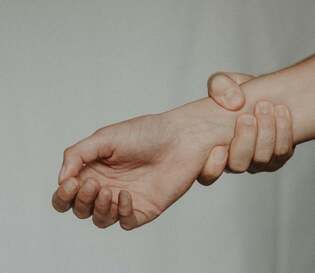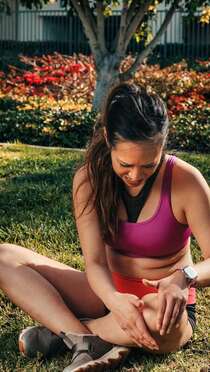|
What is a wrist sprain? Wrist sprains are a general term used to describe any injury to the wrist that doesn’t include a fracture, but is most likely to be a ligament injury. While this can indicate that they are not serious injuries, wrist sprains can be complicated injuries that require supervision and treatment to recover fully. The wrist refers to the area where the bones of the forearm, the radius and ulna, meet and join the bones of the hand. The wrist is able to twist on itself and allows the hand to move to face palm up (supination) or palm down (pronation). The hand is also able to move up and down (flexion/extension) and side to side (abduction/adduction). To allow such complicated movements, the joint surfaces of the wrist are held together by a series of ligaments. When a wrist is sprained, it is usually these ligaments that have been damaged. What are the symptoms?
The primary symptom of a sprained wrist is pain with movement of the joint or when taking load, such as when holding a heavy object. Ligament injuries are given a grading scale to indicate their severity, which can help to guide treatment. Grade 1 refers to a stretching or laxity of the ligament fibres and injuries of this grade usually heal with rest within 2-3 weeks. A grade 2 classification signifies that there has been a partial tear of the ligament fibres and will often need more time and treatment for recovery. Grade 3 tears refer to a full thickness rupture of a ligament and may require splinting or even surgery. The most common cause of a wrist sprain is a fall onto an outstretched hand. Ligament injuries can also happen gradually through over use, although this is less common. What is the treatment? Your physiotherapist is able to help diagnosis a wrist sprain and can help to rule out a fracture. An X-ray might be required and your physiotherapist will perform special tests to help identify exactly which structure has been injured, also giving the injury a grade, to help guide treatment. How can physio help? The key to effective recovery for a wrist sprain is ensuring that the right treatment protocols are in place for your particular injury. Grade 1 sprains will recover best with gentle exercises and early strengthening while Grade 2 to 3 injuries may require splinting or even a surgical consultation for repair. If surgery is the right course for you, your physiotherapist is able to guide you through this treatment pathway, helping you to prepare and recover from surgery to get the best outcome possible.
1 Comment
Knee pain comes in many forms with many different causes. While treatment for every person and condition will be different in each case, here are a few tips that may help to reduce your knee pain throughout the day. 1. Choose supportive footwear
One of the biggest culprits for ongoing knee pain is wearing unsupportive or high-heeled shoes to work. High heels often lead to tight calves and altered gait patterns, while unsupportive shoes can allow rolling in of the feet, which can then place extra stress on the knee joints. Having an assessment with your physiotherapist to see how your shoes might be affecting your knee pain is a worthwhile investment. 2. Adjust your sleeping position While most of the time, our knees get a well deserved rest during the night-time hours, there are a few sleeping positions that can place additional stress on the knees. Lying on your side with bent knees can place tension on the outer thigh muscles and the knee joint itself. Try to keep your knees straightened to only 30 degrees of bend and if you sleep on your side, place a pillow underneath the top knee to reduce stress on the joint. Alternatively, if you sleep on your back it may be helpful to place a pillow under your knees so that they rest in a slightly bent position, to unload the joint. Try experimenting with different pillow arrangements to see which combination works best for you. 3. Avoid sitting or resting too much When knee pain strikes, your first instinct is probably to get off your feet and stop exercising. The truth is that our knees, like all our joints, are designed for movement and regular exercise helps to keep them healthy. If you are having pain with high impact activities such as running, try switching to swimming and cycling before stopping exercise altogether. Resting in a sitting position for prolonged periods can also place excess stress over the knee cap and knee joint. When sitting for long periods, try to stretch your legs out ahead of you and avoid crossing your legs. 4. Seek physiotherapy treatment Many of us see putting up with pain as a sign of strength however, a small niggle that is easily treatable can turn into a larger problem if left over time. This may seem like an obvious point, yet the first step to recovery is often just seeking treatment. Our physiotherapists are happy to discuss your condition with you and share their tips to help you stay pain-free. |
Categories
All
|
|
The Physio Nook
197A Scarborough Beach Road Doubleview WA 6018 08 9446 7017 doubleview@thephysionook.com.au |



